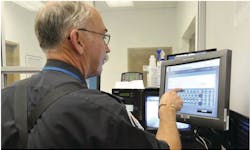54,000 videos per year. The Toronto Police Service (TPS) has historically processed this many incoming and outgoing videos annually. Some simple math says that five years would create 270,000 videos, 25 years makes roughly 1.35 million videos. Not wanting its officers having to hold onto the videos in their desks, 15 years ago the then police chief wanted a central repository of all videos to streamline chain of custody and continuity for court and created the TPS Video Services Unit.
“We developed a system in-house that’s called the Video Tape Management System,” says John Sandeman, Manager of the VSU. Originally based on a barcode system recording on VHS tapes, the system bar coded each individual piece of video to represent the video tape – even the shelves of the storage facility and machines were bar coded.
While managing all videos, the VSU recognized they might have to store them for 25 years – some cases like homicide or sex crimes requires this lengthy shelf life for the parole board. “We recognized that eventually we are going to run out of storage and we were going to have to think of something quick to mediate that issue,” notes Sandeman. Video Services began a long process of converting their VHS process to DVD – saving significant space on the shelf – in a system dubbed Digital Video Asset Management System (DVAMS) with the intention to eventually progress toward getting video onto the TPS network.
However, back 10 years ago, says Sandeman, their networks weren’t capable of handling video. Jokingly he remembers that if you’d mention to put video on the network to an IT person that “they’d have a heart attack.” Video requires a substantial amount of bandwidth and also requires a high quality of service. Combating this, the VSU decided to take the process step by step - somehow predicting that networks might be able to handle video as they can today.
When possible, Video Services used commercial of the shelf DVD recorders, again each video receiving its unique barcode for storage and tracking purposes. “Converting recording all interviews from VHS to DVD bought us some time,” says Sandeman.
The VSU also started recording all newscasts on the network with the Verage program which records all national and international newscasts. Every morning staffs members go through the feed collect the crime stories and edits them out to a link sent to senior officers and command officers. This allows Sandeman to “test” Toronto’s network – to see the robustness. “It’s really not mission-critical video … it gives us an opportunity to test what the network can handle."
The next step originated from recommendations from coroner requests: to record the jail cells 24-7. If recorded onto tape storage would become a problem again if not add to it, let alone require a massive amount of video tape to record every single jail cell in the city. “We moved into the digital era and went with Panasonic DVRs,” says Sandeman. Installed on edge servers within the network, the devices would record footage onto a cache drive marking 30 seconds prior and after movement with motion capture software to catch the full events of whatever happened in the cell.
With treading the waters of the digital world, Toronto then needed to integrate software to manage the files - one cannot put a physical bar code sticker onto a digital MPEG file. MediaSolv, a video and media management company previously of TranTech worked with TPS to bring all video assets into the MediaSolv application to be able to manage them in a case level. It's common, according to the company, that law enforcement can have many different asset types in a number of stove pipe systems. Jim Weaver, President and CEO of the MediaSolv Solutions Corporation explains that the company has two primary products. First is a video information management application, allowing them to go in and set up cameras and microphones in interview or interrogation rooms for example. Second is the MediaSolv product, the media integrated digital evidence management system (IDEM). "That application manages a multitude of digital asset types," says Weaver. These types can include video, audio files, photographs and documentation.
"Anything that can be digitized can be managed within the MediaSolv application," he adds. This capability allows the system to manage the disparate set of evidentiary assets in one system. In a quick picture of the sheer number of differences of collected digital evidence, Weaver mentions that agencies might be managing one system managing interrogation or custodial interview room video, another for in-car video, on-officer video, ECD video, their own building surveillance and commercial surveillance - and many of them might be in different file formats.
"The problem with that is that all of them might have proprietary software," says Sandeman. He explains it's not as simple as burning a DVD of the collected files and uploading them onto the system, because the software may require a specific reader to view/play the file. In these cases, Sandeman says, VSU must transcode the video to a format the system can use. The trick here is to make sure video services has all the necessary tools to transcode the majority if not all the possible software collected video may arrive with.
Implementation
As previously explained, MediaSolv's integration into the TPS consisted of combining four legacy systems. This allowed the solution to enable a single sign-in process. The company also developed multiple interfaces for some other legacy systems as well.
Throughout the project, Sandeman met the chair of an executive steering committee of command officers on a weekly basis - meeting with the entire committee once a month. This gave the project a business process garnering current status and direction.
In addition, TPS also created a user group of field officers to examine processes and any GUI (graphical user interfaces) pages asking their opinion, improvements, figuring if it was going to work in the real world or not and how files may be managed.
"Even during the rollout, we'd get feedback from more officers saying 'can't we have this,' 'can't we have that;' you have to be careful to some extent ... everybody's got their own likes and wants. You have to draw a benchmark and a base line of what's good for the business practice for the organization," says Sandeman.
Proof of concept
For a soft launch, Toronto's Video Service's DVAMS faze 2 rolled out carefully and strategically December 2009 with a single unit. Then in February and every two weeks after TPS entered another unit into the system. Currently, TPS has integrated three of its divisions, traffic services, homicides, sex crimes and fraud departments. The three divisions also serve as regional breath testing centers. According to Sandeman, from January 1, 2010, to April 30, 2010, TPS has recorded over 9, 500 assets on DVAMS 2. "And that's just in five locations in a period of four months, we have 17 divisions throughout the city," he adds.
The system begins at recording an event with the latest digital/analog cameras. Sandeman explains they did not utilize IP cameras attached to the network if fear if the network ever went down, the cameras would be useless. The cameras are connected to a digital amplifier and split: one to an encoder, the other to a DVD recorder - the encoder converts the digital video onto the network.
"So in the event that the network goes down, the officer has a DVD recorder right beside ... the last thing you want is someone to admit to a homicide or a sex crime and the technology fails at the most crucial time. We needed a redundant quick back up," says Sandeman.
Further, the network's primary encoder is backed-up by a secondary encoder. Although the system is reliant on DVAMS, that system is reliant on the TPS Criminal Information System. If that fails, DVAMS is designed to recognize it is down and switch to a manual mode forcing officers to key-in information. Later, when restored, the system has been designed to validate it and automatically
update changes.
That's just the back-end of the system. The front end (user) begins with the single log-in at a video evidence touchscreen (VET). TPS developed touchscreen kiosks, much like ticket kiosks at the airport, for database access. Authorized user actions are logged for date, time, badge number, etc. - data stored as metadata for the requested video file. The officer touches an on-screen button based on required action, booking, transfer in/out, release, or held in custody for example with each action/choice logged.
To illustrate, when booking a suspect the computer pulls data about the arrestee, validates the information and since DVAMS is connected with the TPS human resources management system the data is then attached to the arrest number. A breath test facility works much the same. An officer is logged in, chooses the appropriate choice and follows the subsequent intuitive menus.
Looking to upgrade?
"Many agencies are starting to look at a centralized repository for their videos because it's the number one evidence, next to fingerprints, they need to get to court," says Sandeman.
However he warns to keep the development going for the correct purpose. During the project, Sandeman says he personally pushed MediaSolv to keep the business driving the technology - not the other way around.
"One of the successes to this project, and I would argue that this is important on any system integration or software development project, is we had good people on both sides: a great client and a lot of people working for us that had to share the goal of getting the system implemented ... in a way that met the requirements of the TPS and their vision," says Weaver.
Reflecting upon his 28-year career of software integration, he knows the value of a true partner relationship when doing a project like Toronto. "Spend some time thinking through what your ultimate requirements are so that there is a clear picture and vision of what you ultimately want to implement," suggests Weaver. However, he does understand that it can be difficult to the early stages because agencies might not fully know what they want until they get into the project.
Coupling this, he also advises, the software integrator and agency alike, to keep flexible on both sides to know that the project might change courses from time to time and have the willingness and understand that it's rare to have enough research done beforehand. "Things change that are going to affect [the project.]," he notes. "Understand where you're trying to get to and have the ability and flexibility to alter course to the extent that you need." He also mentions that strong project management on both sides and a making sure the integrator has a good clear understanding of the objective. MediaSolv has also worked in Washington, D.C.; Chicago; Newport News, Va.; and Salinas, Calif.
Sandeman recommends starting small: "I wouldn't get concerned that we're a big agency and we're networked (TPS uses a LAN). I think Chicago and Washington started with just their Homicide bureau with two rooms recorded onto a server ... now they're looking at moving forward to network it."
Adding that, "the good thing about digital networking is you can always expand."
About the Author

Jonathan Kozlowski
Jonathan Kozlowski was with Officer.com, Law Enforcement Technology, and Law Enforcement Product News from August 2006 to 2020.
As former Managing Editor for Officer Media Group, he brought a dedicated focus to the production of the print publications and management of the Officer.com online product and company directory. You can connect with Jonathan through LinkedIn.
Jonathan participated as a judge for the 2019 and 2020 FOLIO: Eddie & Ozzie Awards. In 2012, he received an APEX Award of Excellence in the Technology & Science Writing category for his article on unmanned aerial vehicles (UAVs) in police work, aptly titled "No Runway Needed".
